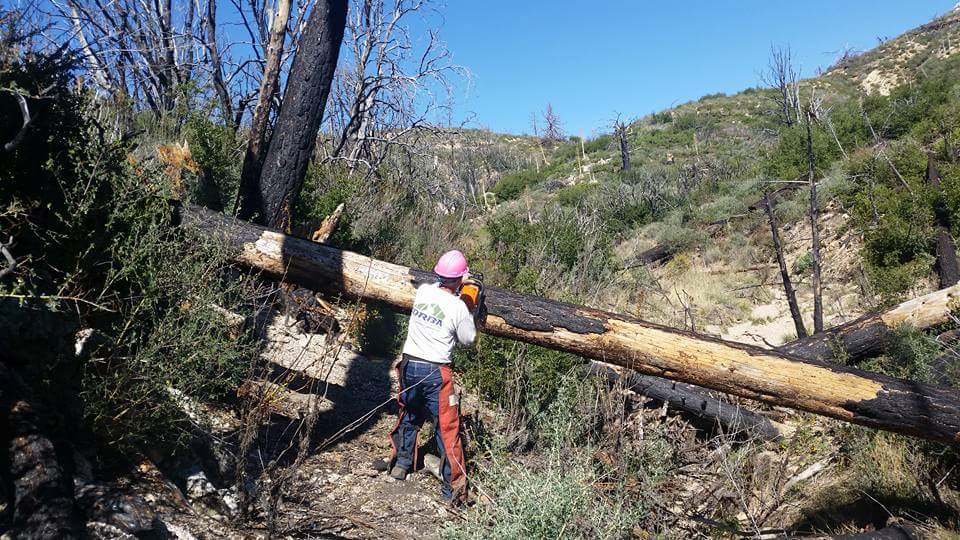Last January the Forest Service allowed some experienced trail maintenance volunteers, who had been previously certified to use chainsaws at the “A” level, to step up their training to a “B” level. Under current regulations, A level sawyers are restricted to 8 inch trees or smaller, and must be supervised. B-level Sawyers are allowed to work unsupervised, on trees up to 24″ in diameter, and can supervise and work with A-level sawyers.
CORBA President Steve Messer, and volunteer Mike McGuire both received their B level certification, and have been putting them to use all year. MWBA volunteers Mitch Marich, Brad Benam and Erik Hillard also received their A level certification, along with several other individuals and volunteers from other organizations and areas outside Los Angeles.
Together the CORBA and MWBA sawyer team has been cutting trees from trails all year. We’ve cut trees from Brown Mountain, El Prieto, Sunset Ridge, Gabrielino, Strawberry Peak, Colby Canyon, Mount Lowe East, Sam Merrill and Silver Moccasin trails. Six years after the Station Fire, downed trees are becoming a major and constant problem.
Our biggest project has been Vetter Mountain trail. This was a favorite of local mountain bikers, as the first descent of the classic Chilao Loop (or, more accurately, the Chilao Figure-8). The area was one of the most heavily impacted areas of the forest by the Station Fire. Drought has slowed the area’s recovery, and there are still thousands of dead trees waiting to fall.
We began in early spring 2015, first clearing the Charlton Flats loop road of more than two dozen downed trees just to get to the bottom of the Vetter Mountain Trail and Silver Moccasin trail. We cleared all the deadfall from the lower section of Vetter through to the first road crossing. There were many trees beyond our chainsaw certification level, the largest being just over 50 inches in diameter. These were taken care of by Little Tujunga Hot Shots Captain Greg Stenmo, whose support we were grateful to have.
After the summer heat and when fire danger levels and wind conditions allowed, on October 3rd CORBA and USFS volunteers Mike and Robin McGuire returned to begin work on the next section of the trail. In a day’s work, they were only able to clear the first hundred feet of the trail, with the sheer number of trees stacked like Chinese pickup sticks.
We returned on October 8th. In the five days since Mike and Robin were up there, another four trees had fallen across the road. Finally getting to the trail, we began cutting downed trees, poodle dog bush and buckthorn from the overgrown tread. In places it was impossible to see any remnant of trail through the brush and deadfall, so having been familiar with the trail in its pre-fire glory was a must. The time lapse below gives a pretty good indication of what’s been involved in clearing the trail. This is six hours of work compressed to nine minutes.
We returned on October 23, and November 5. On November 5 we started from the top of the trail, near the site of the old lookout and worked our way down. It was a glorious moment for us to finally have cut and cleared over 150 trees from Vetter Mountain trail, Charlton trail, and the Charlton Loop road. After finishing, we went back and inspected the trail from top to bottom, and found a dozen more trees fallen in areas we’d previously cleared.
Once again we returned on December 17, first clearing downed trees off the road, then several new trees that had fallen across Vetter and Charlton trails. Afterwards we joined the Chilao hotshots crew, who were clearing downed trees from Silver Moccasin trail after the particularly strong windstorms of December. With our help, they were able to get the job finished in one day.
The trail remains closed to the public. There are still too many dead trees that have been rotting away for six years, waiting to fall every time the wind blows. More than once, when we finished our day’s chainsaw work as the afternoon winds started blowing, we heard more trees falling. Because of these dangers, we are not willing to take in volunteer crews to begin restoring the trail. Since winds have been blowing steadily this past month (over 70mph the week before Christmas), there are probably many more trees down again.
Currently the Forest Service, along with Fire Crews and us as Volunteer Sawyers, are developing a plan to clear remaining standing trees in the trail and road corridors, so that they don’t continue to fall across the trail every time the wind blows. Currently crews are doing that along the Santa Clara Divide Road so that it can be reopened to vehicles next year.
We hope to begin restoration work on the Vetter Mountain trail next year, after we finish the Ken Burton trail. Stay tuned for details.





